By Paul Freary
The Cascadia has long been Brooks’ most popular trail-going model.
The Caldera became Brooks’ most cushioned off-road shoe last year when it was upgraded to the brand’s nitrogen-infused midsole cushioning.
For the summer of 2025, the Cascadia 19 joins the Caldera 8 in using nitrogen-infused foam for cushioning.
So, which is best and which should you choose for your next off road adventure?
If you click, or buy from, links on this page, we may receive compensation. Learn more
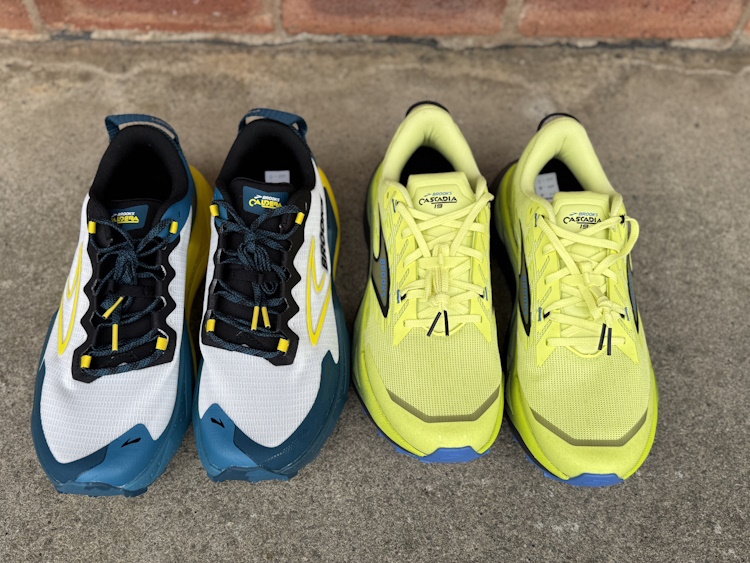
Cushioning
The Caldera 8 was Brooks first trail shoe to introduce the use of their nitrogen-infused foam midsole. Aimed at ultra-distance trail runners, the deep stack of this energized midsole made the shoe an instant hit, being one of the most comfortable trail shoes around.
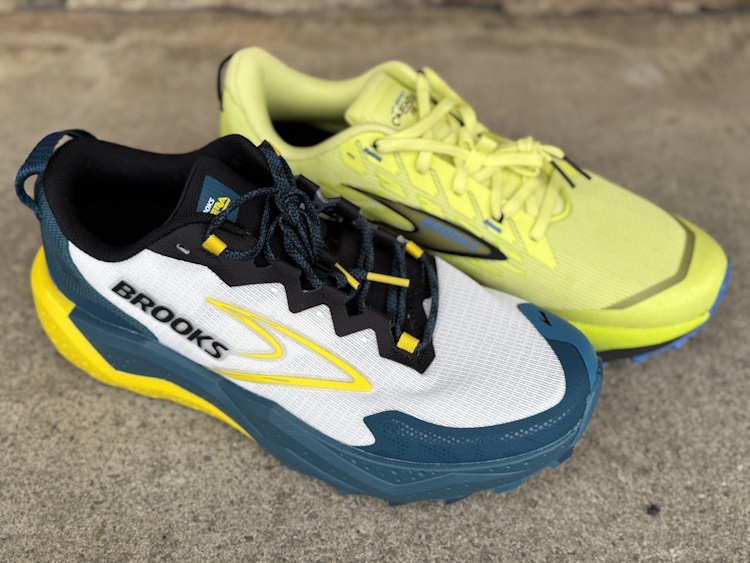
The Cascadia 19 now also uses the brand’s DNA Loft v3, nitrogen-infused foam midsole. This transforms the overall comfort of the shoe over the previous version and makes it a much closer comparison to the Caldera 8.
DNA Loft v3 is softer, springier and more durable than the previous, CM-EVA-based foam and offers an all-around improved, more responsive ride.
Stats
Brooks | CascadiA 19 | Caldera 8 |
|---|---|---|
Best for | Daily training on the trail | Fast training Shorter racing |
Support | Neutral | Neutral |
Cushion | Mid/High cushioned | High cushioned |
Stack Height | 35mm Heel | 38.5mm Heel |
Drop | 6mm | 6mm |
Weight | Men 303g (10.7oz) | Men 300g (10.6oz) |
Suggested Retail Price | $150 | $150 |
Fit | True to size | True to size |
Rating | 9.5/ 10 | 8.5/ 10 |
Stack Height
Although the Cascadia 19 has increased in stack height over the previous version, it isn’t quite as deep as the Caldera 8.

The Cascadia 19 is now 2mm higher in the heel and 4mm higher in the forefoot compared to the Cascadia 18 and now measures 35mm in the heel and 29mm in the forefoot, with a 6mm drop.
The Caldera 8 is higher at 38.5mm in the heel and 32.5mm in the forefoot. So, while around 3mm deeper, its heel drop is the same at 6mm.

All these numbers and dimensions considered, the Cascadia 19 to me feels a little bit softer.
Perhaps the deeper stack of the Cascadia makes the midsole a little denser or maybe Brooks has slightly tweaked the formulation, but it does feel a little softer.

Caldera 8
Shop Now at
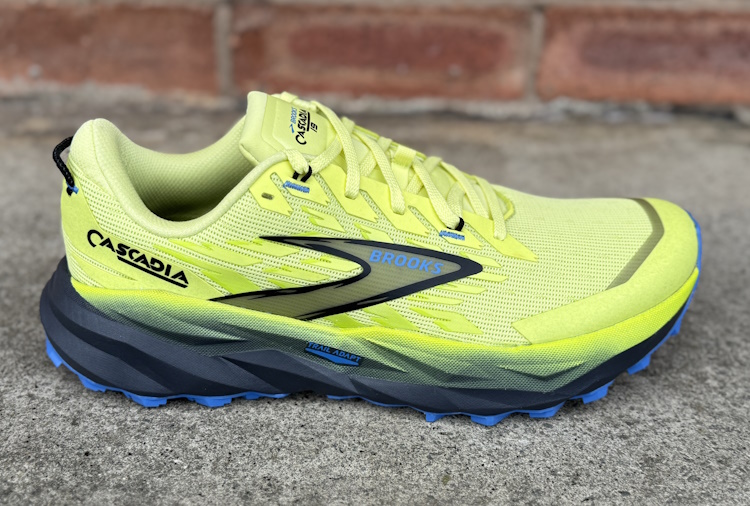
Cascadia 19
Shop Now at
Sole-to-Sole
The Flexible rock plate used in the Cascadia is embedded within the midsole cushioning. This serves the main purpose of preventing sharp rocks and stones from penetrating the midsole foam and causing potential injury to the feet. The flexible plate also provides a little stability and added propulsion. Okay, this is in no way the same as a carbon-plated road racing shoe, but it does provide a little extra toe spring.

The Caldera doesn’t use a rock plate but doesn’t really need one. Given its maximal cushioning, there should be very little chance of rocks penetrating the midsole.
The outsoles of both shoes are very similar in terms of the lug depth and distribution across the shoe. Both shed mud easily, and both used recycled rubber as part of their content.

The lug patterns are miniature chevron designs, with the point of each being reversed in the heel to provide grip when descending and in the opposite direction in the forefoot to create traction when ascending.
Fit
In terms of length, both the Brooks Cascadia 19 and Caldera 8 fit true to size. The width is also true to size, but in the Cascadia, it now feels a little roomier thanks to the softer, more open knit construction of the mesh upper.
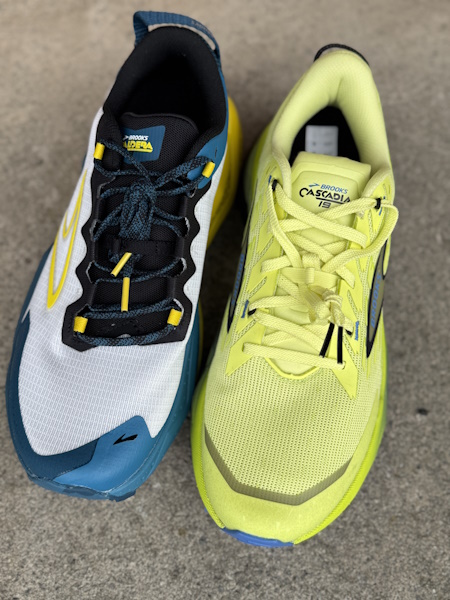
In the Caldera 8, there is more volume to the overall fit of the shoe and, in particular, the toebox area. Being aimed at ultra-distance runners, this allows for the foot to swell after extended time on the feet.
Stability
Both the Brooks Cascadia 19 and Caldera 8 are trail running shoes and, like the vast majority of trail running shoes, they are neutral models.
Due to the undulations of the trails, manufacturers make their trail models neutral. This allows them to more easily adapt to the ground.

The Cascadia 19 does have a relatively wide footprint, and this does add to the shoe’s natural stability, as does the slightly extended midsole on both the lateral and medial sides of the shoe in the rearfoot area. Like the brand’s GuideRails system, these extended sections seat the foot within the midsole for a little added stability.
The Cascadia’s flexible rock plate also adds a little lateral stability to the shoe, although I would not recommend relying on this to control overpronation.

The Caldera 8 has a higher stack, but also a slightly broader footprint, which again, aids natural stability.
The midsole of the Caldera also wraps up a little around the rearfoot and seats the foot within the cushioning, creating a stable feel.
Performance
When I first ran in the Caldera 8, I thought it was the most comfortable trail shoe I’d ever experienced. For long miles off-road, the introduction of the nitrogen foam midsole transformed the ride and smoothed out every step on the trails.
Introducing this premium midsole foam to the slightly nimbler Cascadia line has not transformed the Cascadia 19 into what might be the most comfortable off-road running shoe we’ve ever seen.
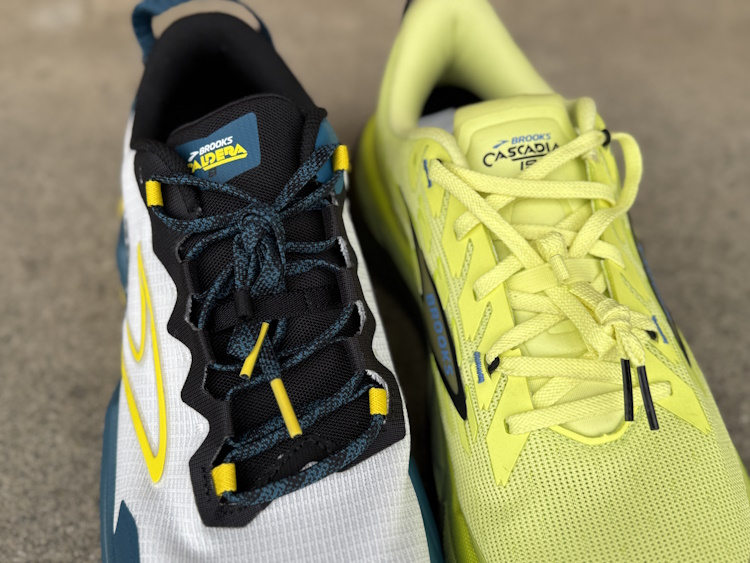
Okay, let’s remember, these are trail shoes, so aimed at a multitude of surfaces that would generally be paths and tracks. We aren’t talking deep mud or wild moorland adventures that would require much more aggressive grip, simply shoes aimed at varying terrain you might encounter ‘out the front door’.
The Caldera still delivers the goods in terms of cushioning and comfort, but the more responsive feel of the Cascadia now gives it the edge in terms of step-in comfort as well as a slightly more adaptable ground feel.

The Caldera is great for longer runs where you simply want comfort and cushioning above everything else.
The Cascadia is more flexible yet still offers the cushioning of the Caldera. Although the Cascadia is ever so slightly heavier than the Caldera, the bulkier nature of the Caldera makes that feel bigger and chunkier on the foot.
Verdict
The Brooks Cascadia 19 gets a resounding thumbs up from me. The shoe has evolved perfectly by incorporating the brand’s DNA Loft v3 foam, and it’s transformed its fit, feel and ride.

For me, every element of the new Cascadia is an improvement. That’s not to say the Cascadia 18 was a bad shoe. In fact, the Cascadia 18 was already one of the best value for money and best all-around off-road shoes on the market. The 19 takes that reputation and improves it in every department.
For those seeking a great value for money off-road shoe, there really is no further to look than the Cascadia 19. In fact, I can’t think of a better trail shoe at any price right now!

I really would like to know which is the wider shoe for wide feet. The Caldera, Cascadia or Cascadia Wide version. And in terms of width how does it compare to Altra’s?
With their wide fit options, the Caldera offers a little more space, thanks to its slightly deeper fit and increased volume. Designed by Brooks to be their ‘ultra-running’ option, the extra volume allows for the feet to swell a little after several hours on the move.
Altra offer several fit variations, and while they are generally wider in the toe box, their design is intended to be more ‘foot-shaped’ rather than simply a wider fit. There are also more differences between Brooks and Altra than purely width or shape, with the Altra tending to be low or zero drop.